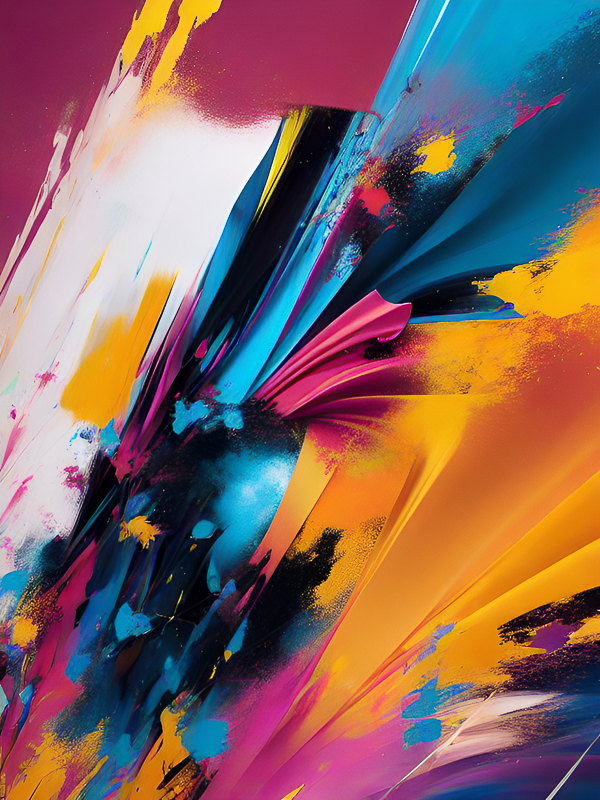Abstract Art: Tachisme art
What is Tachisme art?
Tachisme, a captivating movement within the realm of abstract art, unfolded in the 1940s and 1950s, particularly in the vibrant artistic landscape of France. The term “Tachisme” draws its essence from the French word “tache,” meaning stain or blot, encapsulating the movement’s focus on spontaneous and gestural mark-making. As a distinctive subset of abstract expressionism, Tachist artists delved into the following key characteristics:
1. Spontaneity and Gestural Abstraction:
– Tachist artists, steeped in the ethos of abstract art, embraced spontaneity in their creations. Gestural abstraction became a hallmark, as their movements guided the development of dynamic and unpredictable compositions.
2. Unplanned Techniques:
– Embracing the spirit of abstract art, Tachist creators employed unconventional techniques such as dripping, splattering, and smearing. These unplanned methods allowed for the infusion of chance and unpredictability into the creative process.
3. Emphasis on Texture and Surface:
– Abstract art enthusiasts appreciate the rich textures and varied surfaces found in Tachist works. Layered applications of paint and the use of diverse tools contribute to the tactile and visually dynamic quality of the artworks.
4. Use of Color:
– Within the realm of abstract art, Tachist artists explored a vibrant and expressive color palette. The emphasis on color heightened the emotional and sensory impact of their creations, adding layers of meaning to the visual language.
5. Subjective Expression:
– Rooted in subjective expression, Tachisme allowed artists to communicate their emotions, moods, and personal experiences through the abstract language of spontaneous mark-making—a characteristic deeply intertwined with the ethos of abstract art movements.
6. Ambiguity and Open Interpretation:
– Reflecting the broader principles of abstract art, Tachist works often exhibit an ambiguous quality, inviting open interpretation by the viewer. The absence of clearly defined forms encourages individual responses to the visual elements, fostering a unique and personal connection.
7. Influence of Automatism:
– Tachisme bears the influence of Surrealist automatism, aligning with abstract art principles. Artists allowed their unconscious minds to guide the creative process, resulting in works that embodied the spontaneity and unpredictability inherent in abstract expressionism.
Prominent Tachist artists, operating within the dynamic realm of abstract art, include Jean Fautrier, Hans Hartung, Pierre Soulages, and Georges Mathieu. This movement significantly contributed to the nuanced tapestry of post-war European abstract art, leaving an indelible mark on the evolution of artistic expression.
How to create Tachisme art?
Creating Tachisme art involves embracing spontaneity, gestural mark-making, and a willingness to explore the unpredictable nature of the creative process. Here are some steps to guide you in creating Tachisme-inspired artwork:
1. Gather Your Materials:
– Select your preferred painting materials, such as acrylic or oil paints, a variety of brushes, palette knives, and other tools. Choose a canvas or paper as your painting surface.
2. Prepare Your Workspace:
– Set up a comfortable and spacious workspace with enough room to move freely around your canvas. Cover surfaces to protect them from paint splatters, as Tachisme often involves dynamic and expressive techniques.
3. Explore Gestural Techniques:
– Experiment with gestural mark-making techniques. This can include dripping, splattering, smearing, and other spontaneous methods. Use different tools and explore how each one affects the texture and appearance of the paint.
4. Embrace Spontaneity:
– Tachisme values spontaneity in the creative process. Allow your movements to guide the application of paint. Be open to unexpected results and let go of the need for precise control.
5. Develop a Color Palette:
– Tachisme often involves a vibrant and expressive use of color. Create a color palette that resonates with your emotions or the mood you want to convey. Consider the emotional impact of different colors and how they interact on the canvas.
6. Layering and Texture:
– Experiment with layering paint to create depth and texture in your artwork. Apply paint thickly or thinly, and use tools to create interesting surface textures. Allow layers to partially or fully dry before adding more.
7. Incorporate Brushwork:
– While Tachisme often involves unconventional techniques, don’t hesitate to incorporate expressive brushwork. Use brushes of various sizes to add detail or define certain areas of your composition.
8. Subjective Expression:
– Infuse personal experiences, emotions, or abstract themes into your artwork. Tachisme encourages subjective expression, allowing the artist’s emotions and experiences to manifest in the visual language of the piece.
9. Step Back and Reflect:
– Periodically step back from your work to assess the overall composition. Tachisme can be a dynamic process, and taking breaks to reflect on your artwork can help you make decisions about what areas to enhance or leave as they are.
10. Embrace Imperfections:
– Tachisme celebrates imperfections and the unpredictable nature of the creative process. Embrace accidental marks and unintended outcomes as part of the expressive quality of your artwork.
11. Consider Scale:
– Tachisme works well on larger canvases that allow for bold and expressive movements. Consider the scale of your artwork in relation to the level of physical engagement you want to incorporate.
12. Significant Moments of Spontaneity:
– Intentionally introduce moments of significant spontaneity during your painting process. These moments can become focal points in your artwork, capturing the essence of your emotional and gestural expression.
Remember that Tachisme is about the freedom to explore and express emotions on canvas. Allow yourself to enjoy the process and embrace the unexpected as you create your unique Tachisme-inspired artwork.



